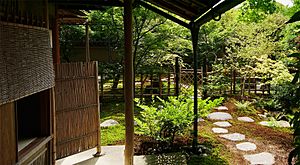Roji facts for kids
A Roji (pronounced "roh-jee") is a special type of Japanese garden. Its name means 'dewy ground'. You usually find a roji garden leading to a chashitsu (tea house). This is where people go to take part in the peaceful Japanese tea ceremony. These gardens are often designed to look simple and natural, creating a calm feeling.
Contents
How Roji Gardens Developed
A very famous tea master named Sen no Rikyū (born in 1522) was important in creating the roji garden style. He believed in simplicity and quiet beauty.
For example, at his tea house called Myōki-an, he made the garden so small that a pine tree's branches would brush against your sleeve as you walked by! This is how it got its nickname, the 'sleeve-brushing pine'.
At another tea house in Sakai, Rikyū planted tall hedges. These hedges blocked the view of the beautiful Seto Inland Sea. Guests could only see the sea when they bent down to wash their hands at the tsukubai (a stone basin). This design made the view a special surprise. Rikyū wanted guests to focus on the tea ceremony, not outside distractions.
Another skilled garden designer was Kobori Enshū (born in 1579). He also helped shape the roji style.
What You See in a Roji Garden
A roji garden is usually split into two main parts: an outer garden and an inner garden. There's often a machiai (a small waiting area or shelter) where guests can wait before the ceremony begins.
Here are some common things you'll find in a roji:
- Tsukubai: This is a stone basin filled with water. Guests use it to wash their hands and rinse their mouths before entering the tea house. It's a way to cleanse yourself before the ceremony.
- Tōrō: These are stone lanterns. They provide soft light, especially for evening tea ceremonies, and add to the garden's peaceful mood.
- Tobi ishi: These are stepping stones placed to guide visitors along the path. They make you slow down and pay attention to each step.
- Wicket gate: A small, simple gate that separates the outer and inner parts of the garden. It marks the transition into a more sacred space.
You won't usually see lots of bright, showy flowers in a roji. Instead, designers prefer plants that create a calm, natural look. These often include soft moss, green ferns, and evergreen trees. Sometimes, you might see ume (plum) trees or Japanese maples, which add seasonal beauty without being too flashy.
Influence on Other Gardens
The roji garden, with its small size and simple, balanced design, became a model for other Japanese gardens. It showed how even a small space could be beautiful and meaningful. Many Japanese courtyard gardens were inspired by the peaceful and simple ideas of the roji.
See also
 In Spanish: Roji para niños
In Spanish: Roji para niños



